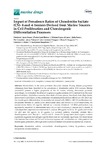Mostrar o rexistro simple do ítem
Impact of prevalence ratios of chondroitin sulfate (CS)- 4 and -6 isomers derived from marine sources in cell proliferation and chondrogenic differentiation processes
| dc.contributor.author | López-Senra, Estefanía | |
| dc.contributor.author | Casal-Beiroa, Paula | |
| dc.contributor.author | López-Álvarez, Miriam | |
| dc.contributor.author | Serra, Julia | |
| dc.contributor.author | González, Pío | |
| dc.contributor.author | Valcárcel, Jesús | |
| dc.contributor.author | Vázquez, José Antonio | |
| dc.contributor.author | Burguera, Elena F. | |
| dc.contributor.author | Blanco García, Francisco J | |
| dc.contributor.author | Magalhaes, J. | |
| dc.date.accessioned | 2020-02-24T10:35:13Z | |
| dc.date.available | 2020-02-24T10:35:13Z | |
| dc.date.issued | 2020-01-31 | |
| dc.identifier.citation | López-Senra E, Casal-Beiroa P, López-Álvarez M, et al. Impact of prevalence ratios of chondroitin sulfate (CS)- 4 and -6 isomers derived from marine sources in cell proliferation and chondrogenic differentiation processes. Mar Drugs. 2020; 18(2): 94-108 | es_ES |
| dc.identifier.issn | 16603397 | |
| dc.identifier.uri | http://hdl.handle.net/2183/25001 | |
| dc.description.abstract | [Abstract] Osteoarthritis is the most prevalent rheumatic disease. During disease progression, differences have been described in the prevalence of chondroitin sulfate (CS) isomers. Marine derived-CS present a higher proportion of the 6S isomer, offering therapeutic potential. Accordingly, we evaluated the effect of exogenous supplementation of CS, derived from the small spotted catshark (Scyliorhinus canicula), blue shark (Prionace glauca), thornback skate (Raja clavata) and bovine CS (reference), on the proliferation of osteochondral cell lines (MG-63 and T/C-28a2) and the chondrogenic differentiation of mesenchymal stromal cells (MSCs). MG-G3 proliferation was comparable between R. clavata (CS-6 intermediate ratio) and bovine CS (CS-4 enrichment), for concentrations below 0.5 mg/mL, defined as a toxicity threshold. T/C-28a2 proliferation was significantly improved by intermediate ratios of CS-6 and -4 isomers (S. canicula and R. clavata). A dose-dependent response was observed for S. canicula (200 µg/mL vs 50 and 10 µg/mL) and bovine CS (200 and 100 µg/mL vs 10 µg/mL). CS sulfation patterns discretely affected MSCs chondrogenesis; even though S. canicula and R. clavata CS up-regulated chondrogenic markers expression (aggrecan and collagen type II) these were not statistically significant. We demonstrate that intermediate values of CS-4 and -6 isomers improve cell proliferation and offer potential for chondrogenic promotion, although more studies are needed to elucidate its mechanism of action. | es_ES |
| dc.description.sponsorship | Xunta de Galicia; IN607A 2017/11 | es_ES |
| dc.description.sponsorship | Xunta de Galicia; IN607B 2018/19 | es_ES |
| dc.description.sponsorship | European Commission; 0245_IBEROS_1_E | es_ES |
| dc.language.iso | eng | es_ES |
| dc.publisher | MDPI | es_ES |
| dc.relation.uri | https://doi.org/10.3390/md18020094 | es_ES |
| dc.rights | Atribución 3.0 España | es_ES |
| dc.rights.uri | http://creativecommons.org/licenses/by/3.0/es/ | * |
| dc.subject | Chondroitin sulfate | es_ES |
| dc.subject | Osteoarthritis | es_ES |
| dc.subject | Chondrogenesis | es_ES |
| dc.subject | Fishery by-products | es_ES |
| dc.subject | Marine compounds | es_ES |
| dc.subject | Circular economy | es_ES |
| dc.title | Impact of prevalence ratios of chondroitin sulfate (CS)- 4 and -6 isomers derived from marine sources in cell proliferation and chondrogenic differentiation processes | es_ES |
| dc.type | info:eu-repo/semantics/article | es_ES |
| dc.rights.access | info:eu-repo/semantics/openAccess | es_ES |
| UDC.journalTitle | Marine drugs | es_ES |
| UDC.volume | 18 | es_ES |
| UDC.issue | 2 | es_ES |
| UDC.startPage | 94 | es_ES |
| UDC.endPage | 108 | es_ES |
Ficheiros no ítem
Este ítem aparece na(s) seguinte(s) colección(s)
-
INIBIC- REUMA - Artigos [184]
-
GI-GIRS - Artigos [95]
-
GI-GIRS - Artigos [95]






